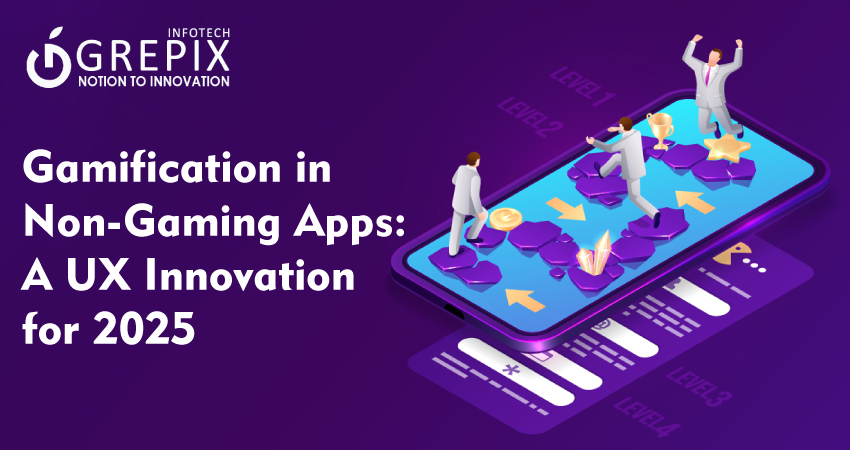Gamification in Non-Gaming Apps: A UX Innovation for 2025
Gamification is no longer limited to the gaming world—it has become one of the biggest UX innovations in mobile app development. In 2025, more businesses are embedding game mechanics like rewards, leaderboards, challenges, and achievements into their apps, even when those apps are not games.
Why? Because gamification works. It boosts user engagement, increases retention, and enhances customer satisfaction. Research shows that apps using gamification techniques see a 60% increase in daily active users compared to apps without it. This is why every software development company and every top leading game app development company is now helping enterprises integrate gamification into apps for e-learning, fitness, healthcare, finance, and even enterprise productivity.
In this article, we’ll explore how gamification is redefining UX, real-world examples, benefits for businesses, challenges, and why it’s a must-have innovation for 2025.
Gamification is redefining mobile app development in 2025 by bringing game mechanics like badges, leaderboards, and rewards into non-gaming apps. From fitness and finance to education and enterprise, gamification boosts user engagement, retention, and loyalty. Leading businesses now collaborate with a software development company or a top leading game app development company to integrate these features seamlessly. Real-world apps like Duolingo, Fitbit, and Starbucks Rewards prove how gamification drives growth and customer satisfaction. While challenges such as overuse and complexity exist, the benefits—higher retention, better conversions, and brand loyalty—make it a must-have innovation. Looking ahead, gamification will be powered by AI, blockchain, and immersive technologies like AR and VR. For CTOs and business leaders, gamification is no longer optional—it is a strategic necessity that determines whether your app thrives in the competitive digital landscape of 2025.
What Is Gamification in Non-Gaming Apps?
Gamification is the application of game mechanics—like points, levels, leaderboards, and badges—into non-gaming environments. The idea is to make everyday app experiences more fun, interactive, and rewarding.
For example:
- Fitness Apps: Earning badges for daily workouts.
- Finance Apps: Leveling up savings streaks.
- Education Apps: Leaderboards for quiz competitions.
- Enterprise Apps: Points for completing tasks on time.
Unlike actual games, the goal isn’t entertainment—it’s behavioral motivation. By rewarding small actions, users feel encouraged to continue using the app regularly.
Why Gamification Is a UX Innovation in 2025
CTOs, product managers, and designers are prioritizing gamification because 2025 is all about user stickiness. With app stores flooded with alternatives, user retention is the real battle.
Here’s why gamification is trending now:
1. Digital Fatigue:
Users are overwhelmed by apps—gamification makes apps enjoyable.
2. Behavioral Economics:
Rewards trigger dopamine, reinforcing habits.
3. Data-Driven UX:
Gamification provides measurable engagement metrics.
4. Cross-Industry Adoption:
From fintech to healthcare, every sector now benefits.
In short, gamification is not just a feature—it’s a strategic UX innovation driving growth for businesses.
Gamification Trends in Mobile App Development
Top app developers and software development companies are embedding gamification with the latest technologies:
1 Personalized Rewards
AI-driven gamification tailors rewards to user preferences.
2 AR & VR Integration
Fitness apps and e-learning platforms use AR-based challenges.
3 Social Leaderboards
Encouraging friendly competition with peers.
4 Progression Systems
XP points, streaks, and levels encourage daily app use.
5 In-App Economy
Virtual coins and rewards can be redeemed for discounts or perks.
Real-World Examples of Gamification in Non-Gaming Apps
1 Duolingo (Education):
Uses streaks, badges, and leaderboards to keep users motivated.
2 Fitbit (Health):
Rewards users for achieving daily step goals.
3 Starbucks Rewards (Loyalty):
Customers earn stars for purchases and unlock tiers.
4 Khan Academy (E-Learning):
Badges and achievements encourage continued learning.
5 Microsoft Teams (Enterprise):
Uses badges and recognition features to boost productivity.
These examples show why top leading game app development companies are now working beyond gaming—helping every industry use gamification as a growth driver.
Business Benefits of Gamification
For companies, gamification isn’t just about fun—it’s about ROI.
- Higher User Engagement: Keeps users coming back daily.
- Better Retention: Reduces churn rates in competitive markets.
- Boosted Conversions: Rewards and achievements encourage purchases.
- Brand Loyalty: Users form long-term emotional connections.
- Data Insights: Tracks user behavior more effectively.
For a software development company, adding gamification means delivering not just an app, but a revenue-generating platform.
Also Read: "Why CTOs Are Prioritizing Scalable Microservices Over Monoliths"
Challenges of Gamification
While powerful, gamification must be implemented carefully.
- Overuse Can Backfire: Too many badges feel gimmicky.
- One-Size-Fits-All Doesn’t Work: Rewards must be personalized.
- Development Complexity: Requires skilled mobile app development teams.
- Balancing Fun & Function: Must enhance, not distract from, the core app purpose.
This is why CTOs prefer working with a top leading game app development company that already understands the psychology of engagement.
Why Companies Must Adopt Gamification in 2025
In 2025, users expect apps to be rewarding and interactive by default. Businesses that ignore gamification risk losing users to more engaging competitors.
For startups, gamification can mean faster growth and viral adoption. For enterprises, it can mean higher employee productivity and customer loyalty.
With the global gamification market expected to exceed $30 billion by 2025, no forward-looking software development company can afford to ignore it.
The Future of Gamification
Looking ahead, gamification will evolve with:
- AI + Personalization: Tailored challenges based on individual behavior.
- Blockchain Rewards: Secure, transferable digital assets.
- Cross-App Gamification: Rewards shared across multiple apps.
- Mixed Reality Experiences: Immersive gamification in AR/VR.
Gamification will no longer be an add-on but a core pillar of UX strategy.
Conclusion
Gamification has emerged as a game-changing UX innovation in 2025, extending far beyond gaming apps. From healthcare and fintech to education and enterprise productivity, gamification is helping businesses drive engagement, retention, and loyalty.
For CTOs and founders, the choice is clear: partner with a software development company or a top leading game app development company that can integrate gamification effectively into your mobile app.
Because in 2025, apps that entertain, reward, and engage will dominate the market.
FAQs
1. What is gamification in non-gaming apps?
It’s the use of game mechanics like points, leaderboards, and badges in apps that aren’t games.
2. How does gamification help mobile app development?
It improves user engagement, boosts retention, and increases conversions.
3. Which industries benefit from gamification?
Healthcare, fintech, education, retail, and enterprise productivity.
4. Why should companies hire a top leading game app development company?
Because they understand engagement psychology and can implement gamification effectively.
5. Is gamification the future of UX?
Yes, in 2025 gamification is becoming a core UX strategy across industries.
Launch your vision with our mobile app development company, where innovation meets excellence to create cutting edge mobile solutions."







